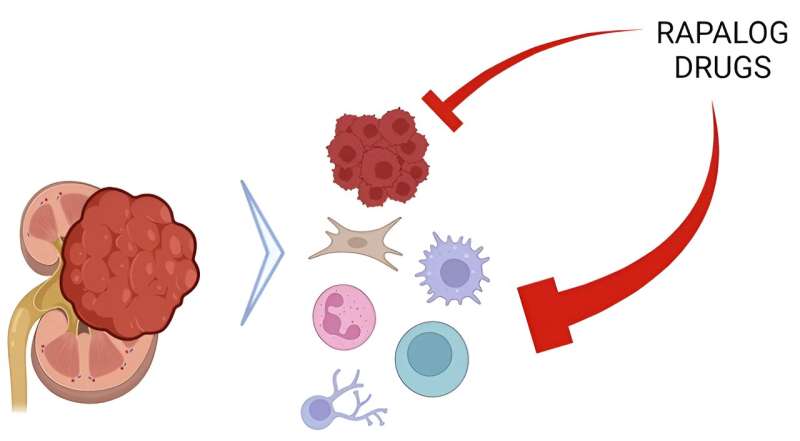This article has been reviewed according to Science X's editorial process and policies. Editors have highlighted the following attributes while ensuring the content's credibility:
fact-checked
peer-reviewed publication
trusted source
proofread
Study reveals unexpected mechanism of drug resistance in kidney cancer

For nearly two decades, how kidney cancer becomes resistant to rapalog drugs has baffled the scientific community. Now a study by researchers at UT Southwestern Medical Center's Kidney Cancer Program sheds light. Published in the Proceedings of the National Academy of Sciences, the study "Unconventional Mechanism of Action and Resistance to Rapalogs in Renal Cancer" provides evidence for an unanticipated role for nontumor cells in mediating the therapeutic effects of rapalogs in kidney cancer.
Rapalogs (or rapamycin analogs) are used to treat renal cell carcinoma (RCC) and other tumor types, but their utility is hindered because tumors become resistant over time. Why this occurs has remained unknown since the drugs were first introduced for kidney cancer treatment in 2007.
Resistance to targeted therapies, such as rapalogs, often involves mutations in the drug target that interfere with drug binding. However, mTOR, the drug target, is not mutated when RCC tumors become resistant.
To model resistance to rapalogs, investigators in the Brugarolas Lab leveraged their tumorgraft program, one of the largest such programs worldwide. As they had done previously when evaluating resistance against HIF2α-blocking drugs (another class of FDA-approved drugs for RCC), they treated mice transplanted with patient RCC tumors with rapamycin until resistance developed. While the drug target is often reactivated when resistance develops, unexpectedly, mTOR remained suppressed in tumor cells.
Previous experiments with HIF2α-blocking drugs revealed that drug resistance resulted from a mutation in HIF2α that allowed it to remain active even in drug-treated tumor cells, and the same results were subsequently found in drug resistant patients' tumors.
However, when resistance against rapamycin developed, the drug still blocked mTOR activity in tumor cells. Strikingly, however, mTOR became reactivated in cells around the tumor, known as the tumor microenvironment (TME).
To determine the role of the TME, investigators engineered mice to make a form of mTOR that was resistant to rapamycin. The researchers hypothesized that if suppression of mTOR in the TME was important for rapalog activity, patient tumors should be less responsive to the drug when transplanted into these mice.
The investigators found that rapamycin was far less effective at killing transplanted RCC tumors in these mice. Thus, even though mTOR was readily inhibited in the transplanted human tumor cells, failure to inhibit mTOR in the TME, which develops from the host mice, caused drug resistance.
These studies merged two traditional but distinct approaches to cancer modeling—tumor transplantation and genetic engineering—and showed that the TME plays a critical role in mediating the activity of rapalogs.
The findings pave the way for novel therapeutic strategies that target the tumor microenvironment. "By broadening our approach to targeting tumor support cells, we can open new avenues to tackle drug resistance in kidney cancer," said lead author James Brugarolas, M.D., Ph.D., Professor of Internal Medicine in the Division of Hematology and Oncology and founding Director of the Kidney Cancer Program at the Harold C. Simmons Comprehensive Cancer Center at UT Southwestern.
More information: Juan Yang et al, Unconventional mechanism of action and resistance to rapalogs in renal cancer, Proceedings of the National Academy of Sciences (2024). DOI: 10.1073/pnas.2310793121



















